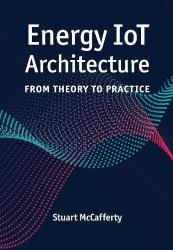Energy IoT Architecture: From Theory to Practice
- Добавил: literator
- Дата: 23-02-2023, 16:52
- Комментариев: 0
 Название: Energy IoT Architecture: From Theory to Practice
Название: Energy IoT Architecture: From Theory to PracticeАвтор: Stuart McCafferty
Издательство: Artech House
Год: 2023
Страниц: 245
Язык: английский
Формат: pdf (true)
Размер: 27.5 MB
This book provides a very common-sense approach to transforming the Electricity Industry to meet clean energy goals and simplifying coordination with DER at scale with plug and play interoperability over time. It shows you a new way to architect solutions using a modern, event-driven, standards-based, elastic, cloud-based, distributed architecture to simplify and abstract communications with utility, customer, and third-party owned clean energy assets.
The book describes the architectural and technological problems of our 20th Century centralized model and provides a pragmatic alternative architecture with examples of how to seamlessly integrate large numbers of Distributed Energy Resources (DER) with centralized systems that take advantage of intelligent edge devices through coordination instead of direct command and control. It also includes references to DOE’s Laminar Grid Architecture philosophy and shows how the Energy IoT Reference Architecture is aligned to solve today’s biggest Electricity Industry problems.
The energy IoT reference architecture was designed to support as-a-service business models that create interoperability and abstracted, streamlined communications between services, systems, and grid assets in an elegant, modern framework. The Green Cloud as-a-service APIs include energy-specific microservices, data repositories, and analytics to facilitate rapid prototyping and development for energy applications. Using the existing DevOps framework and microservices provided by the major Cloud vendors, these Cloud vendors already provide core techniques, scale, and virtualization necessary to support a DER-rich, bidirectional energy flow, dynamic, and adaptive grid. However, the Cloud vendors provide generic solutions and do not include the energy-specific additional services provided by the Green Cloud. These new Green Cloud services and framework leverage existing Cloud vendor capabilities and build energy data-centric models and repositories with supporting data services as the centerpiece of the architecture.
We will introduce the energy IoT reference architecture, which leverages modern architectural elements, such as virtualization, containerization, orchestration, rich semantic information models, message buses, DevOps microservices, and the Cloud. This architecture:
• Is elastic;
• Is scalable;
• Is service-oriented and event-driven;
• Uses Internet Protocol (IP) addressing schemes;
• Will enable both edge computing and support legacy centralized situational awareness computing needs;
• Is data-centric;
• Provides encrypted and authenticated communications, protects customer and data privacy, and provides role-based access to data;
• Uses rich semantics for communication (interoperability that is message-based instead of registry-based);
• Is extensible;
• Is designed to be future-proofed with the ability to adapt and extend API services;
• Provides fail-safe and redundant operations of edge assets;
• Can be located on site, in the Cloud, distributed on the grid edge, or in any hybrid combination of those options;
• Employs distributed hierarchical control and coordination;
• Is designed with expected communication losses.
You’ll find detailed explanations of common energy IoT reference architecture; understand integration of utility, customer, and third party distributed grid assets to support grid services and market opportunities, and master the elastic scalability solution which is considered by many to be the biggest problem in utility systems for DER. This is a must-have resource for architects, engineers, software developers, government officials, undergraduate students, and professors.
Скачать Energy IoT Architecture: From Theory to Practice
[related-news] [/related-news]
Внимание
Уважаемый посетитель, Вы зашли на сайт как незарегистрированный пользователь.
Мы рекомендуем Вам зарегистрироваться либо войти на сайт под своим именем.
Уважаемый посетитель, Вы зашли на сайт как незарегистрированный пользователь.
Мы рекомендуем Вам зарегистрироваться либо войти на сайт под своим именем.
